Media | Articles
The Hack Armada: Admitting the Mistake
Okay. I’m calling it. Time of death of thinking that buying the 182,000-mile 2008 Nissan Armada was a good idea: June 19, 2024, 11:03 a.m.
It all made sense at the time. I’d sold the giant 2008 Chevy Silverado 3500HD dually diesel because it was worth real money and I wasn’t using it, and soon I missed having something I could tow with if I needed to, so I began looking for a replacement. In the SUV-versus-pickup calculus, a big enclosed passenger vehicle made more sense to me than a truck. I didn’t want anything German as I didn’t want the expense, and I’d owned a parade of Suburbans and wanted to try something different, so I thought I’d try ordering from the Japanese menu. Reliability ratings steered me to the second-generation Toyota Sequoia, but the “Toyota tax” was all too real a thing, and I just didn’t want to spend upwards of eight grand for a 200,000-mile vehicle. Nissan Armadas were plentiful in the sub-$5K range, and when I found this running, driving black-on-black 2008 LE with the tow package in need of odds and ends for a negotiated price of $3250, I ended the search.
Bad idea.
To be clear, nothing has gone horrifically wrong with the Armada. I’ve barely used it. As was the case with the Silverado before it, there’s a serious gap between my self-image of needing something truck-like to be able to tow a trailer so I can drop everything and bag needy inexpensive vehicles versus the actual reality of doing it. As I’ve described in numerous pieces, the Armada needed the exhaust repaired to pass inspection, the radiator replaced, power steering leaks squelched to be reliable, the front suspension redone to be something resembling comfortable, and a mouse smell to be tracked down and dealt with to be driven with the windows up and the fan on.
But even without my really using it, its needs haven’t let up. I recently dealt with the rear suspension. I thought that the tow package was a plus when I bought it, but people on the Armada forum complain about the self-leveling system (springs with shocks that have air bags integrated into them, inflated by a compressor tied to a level sensor), and when it malfunctions, most folks replace the stock springs with stiffer ones from Moog and the shocks with Bilsteins, as I did in the front. Whether I did that depended on how much of the pneumatics in my vehicle were bad. The air bladders in the rear shocks were clearly torn, but I could hear the compressor run.
Marketplace
Buy and sell classics with confidence
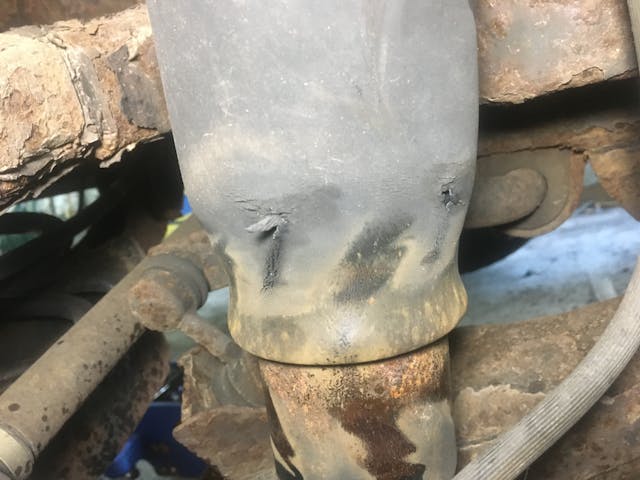
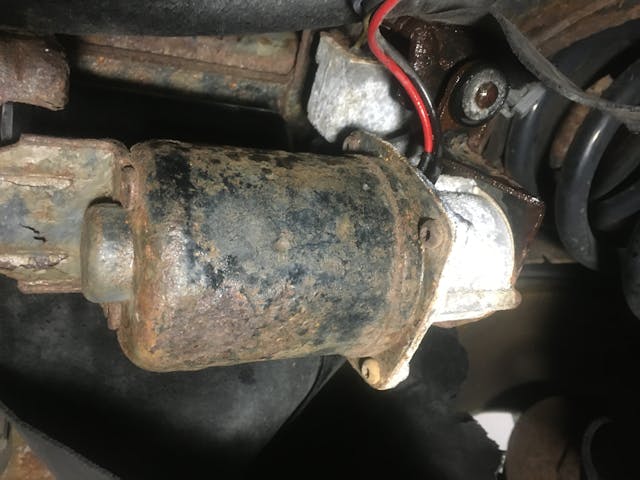
I tested my system and found that the compressor ran, but a solenoid inside it was seized and prevented air from flowing out and into the shocks, so I removed it to troubleshoot it.

I unstuck the solenoid with Silikroil, but that still didn’t result in it outputting air. The idea that you’d toss the compressor for what seemed to be a replaceable part was ridiculous, but the solenoid is integrated into a pneumatically sealed cover, many other folks had gone down this road, and no one on the forum either identified a replacement part or described a way to arthroscopically repair it.
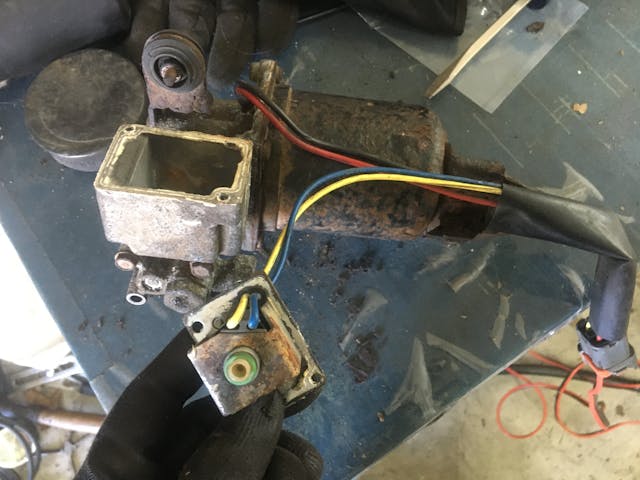
The compressor and air bladders in my shocks being bad meant that the cost of replacement using decent-quality aftermarket parts was about $350, and for that I could buy the Moog springs and Bilstein shocks. Which path you take depends on how important the self-leveling system is to you. On the one hand, the odds of my towing a big trailer are slim, so removal made sense. On the other hand, replacing the rear springs requires unbolting one end of the rear wishbones, which I knew were rusty, and the path of going down the rabbit hole and rebuilding the rear end of a vehicle I had no attachment to was something I wanted to avoid. I decided that I’d let the condition of the car guide my path. That is, I’d carefully inspect the rear suspension. If the wishbones were rotted clean through, I’d dump the Armada and cut my losses. If they were solid but the springs were broken (as they were on the front) or badly corroded, I’d dump the pneumatics and go the Moog/Bilstein route. If it was a wash, I’d let the availability of well-priced parts dictate the way.
The rear springs looked fine with their black coating still intact. The wishbones, though, were concerning. There was no avoiding the fact that, like the rest of the undercarriage, they showed the 182,000 miles and 15 New England winters. However, I could not find any signs of actual rust-through, so I gave them a barely passing grade.
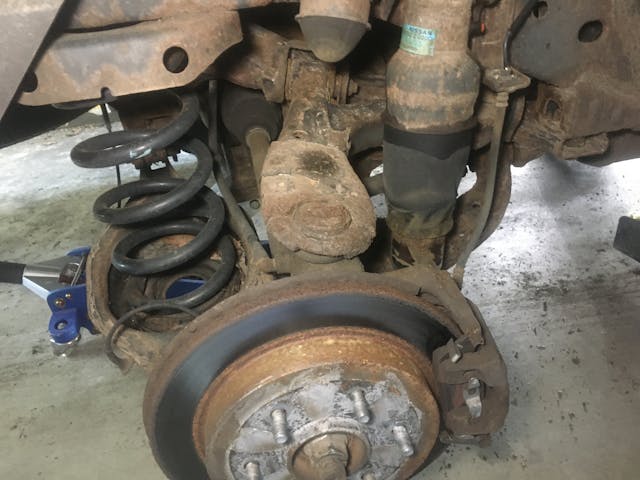
That passed the ball to the question of economics. I did find a brand-new OEM compressor and new OEM air shocks on Facebook Marketplace that two different owners bought but never installed, and I almost pulled the trigger on them when I found a set of new open-box Bilstein shocks on eBay for about half of new. Folks on the forum strongly recommend that they be paired with the stiffer Moog 81085 springs, but I figured I’d install them with the original springs and see how well they work. I mean, two bolts for each shock—quick in and out, right?
Of course, no original suspension component on a lifelong New England vehicle comes out easily. The bottom bolt in one of the shocks was seized to the metal sleeve through the rubber, and the only way to remove it was to air-hacksaw through both sides of the bolt.

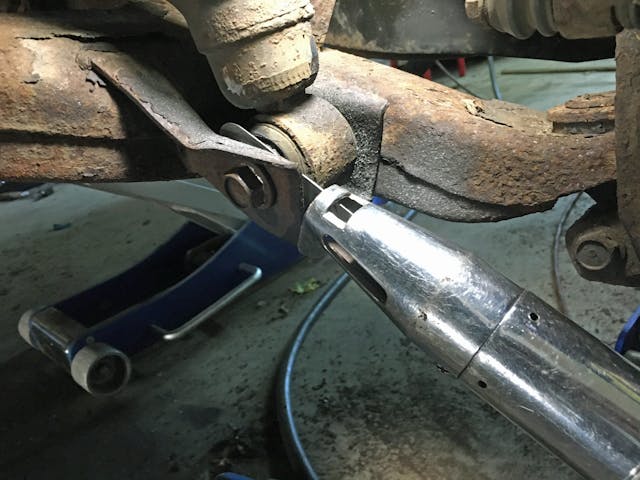
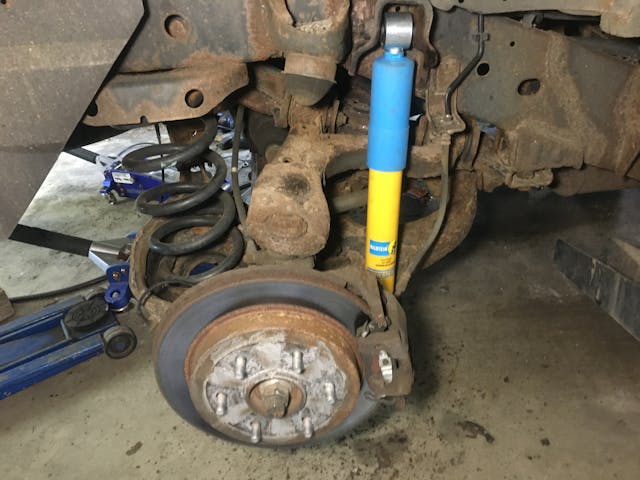
So the rear Bilsteins are in. I filed the question of the rear springs in the “When I rent a U-Haul auto transporter and see how much the tail sags and I find a set of Moogs for half price” folder.
With the suspension at a good stopping point, I felt that most of the Armada’s immediate needs were met. However, several non-reliability issues bugged the ever-living hell out of me.
First was the leak. Whenever it rained, I’d find water on the passenger-side floor (fortunately there are rubber floor mats, so most of the water stays off the carpet).
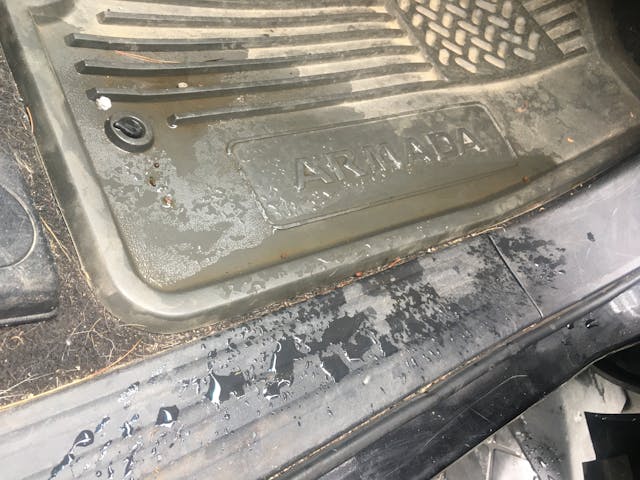
Then I remembered that, when I bought the car, there was water in this same spot. I asked the seller about it, and he lied through his teeth and said that it was due to snow from the roof having fallen inside when he opened up the door. It turned out that the sunroof was leaking and had been for quite some time. It was obvious from the staining down both A-pillars. I’m stunned that I didn’t see it when I was looking at the car.
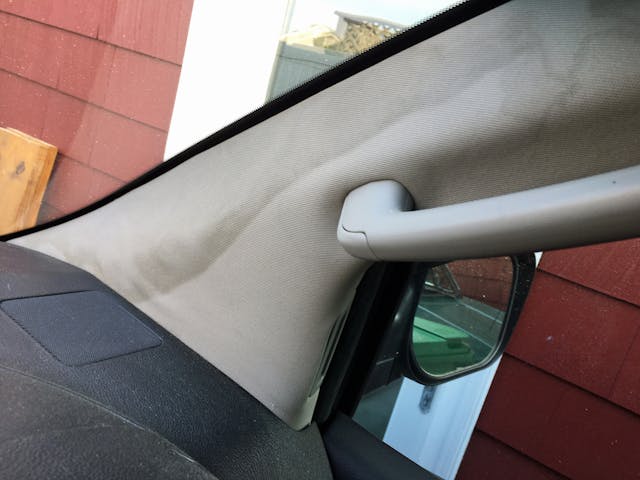
I also didn’t see that, in an attempt to stanch the leak, someone had sealed the entire sunroof—not just the seam between the roof and the panel, the entire thing—with a single adhesive sheet.

Since water clearly wasn’t getting in through the sunroof seal, I assumed it was coming through the windshield gasket, but testing with a hose was negative. I’m still not certain what the path of ingress is, but the leak down the passenger-side A-pillar was so specific that I removed its covering to expose the leak itself, then pulled the front right corner of the headliner down, looked above, and found that the drain hose from that corner of the sunroof pan had popped off. I reattached it and haven’t seen any leakage since.


Next was the air conditioning. One thing I despise about modern cars is that you can’t easily test the A/C in winter because the car’s smarts may measure the outside temperature, see that it’s 35 degrees out, and decide that you don’t, in fact, need the A/C on. This was the case with the Armada; I couldn’t tell whether or not the A/C worked when I bought it. As spring edged toward summer, though, it was clear that it didn’t.
I connected my manifold gauge set and it registered pressure, so the system wasn’t empty of refrigerant. Just about any car built with A/C in the last 50 years has a pressure cut-off switch, usually on the receiver-drier, to prevent the compressor from running if there’s not enough refrigerant, so the next thing to do is to hot-wire the compressor—wire it directly to the battery—and see if the clutch inside it engages and if the system the produces cold air. Due to a combination of the Byzantine nature of modern electrical connectors and the car’s age and mileage, I could not for the life of me get the connector separated, so I used a pin to back-probe the connector and clamped a hot 12-volt wire to it. The compressor clutch made the metallic CLANK signaling engagement and the dials on the manifold gauges swung in the appropriate directions, indicating that things were functional. I shot a can of R134a into it and the system woke up and began to blow cool. Another can turned it cold.

Unfortunately the A/C honeymoon lasted only about three weeks. As you may know, I do a fair amount of A/C work, and I even wrote a book about reviving long-dead A/C systems called Just Needs a Recharge. What you may not know is that the title is a joke. It’s like “ran when parked” (the title of one of my other books) which trivializes things in the same way. If a system needs to be recharged, it’s because it’s low on refrigerant, which means the refrigerant leaked out, which means that the system has a leak. If you’re lucky, the leak is something like a single O-ring at a connection that’s easy to identify and repair. But the newer the car, the more complex it is, and the harder it is to find and fix leaks. The Armada is a vehicle with rear air, plumbed by metal hoses that run the length of the car. The forum reports that leaks in these lines, both at connections as well as right in the middle, are common. And it’s obvious that the in-headliner rear A/C has been mucked with, as the covers and screws clearly have been disturbed. I used my refrigerant sniffer leak detector inside and under the car, but found nothing. There didn’t seem to be any UV-fluorescent dye in the system, so I shot some in, but as of yet, poking around with the black light, I haven’t found anything suspicious. Getting through the summer by shooting cans of R134a may be easier than a full-on leak-detection assault, but it also makes me circumspect about using the truck the way I’d intended to. The idea of getting caught in a black-on-black vehicle in August with no A/C is not my idea of fun.
Then there’s the sagging passenger door. I was aware of it when I bought the truck, and my wife noticed it the first time she got inside. It’s nothing in terms of affecting functionality, but it really bugs me, as it’s like a tip-of-the-iceberg reminder that the car is junkier than I’d hoped it would be. The frustrating thing is that, on paper, it should be easy to fix. The play is coming from worn-out bushings on the pin on the lower hinge. The correct way to fix it is to replace the hinge. It’s an inexpensive part from Nissan, something like twenty bucks, but the fender has to come off to install it. It’s just a bolt-on body panel, but the fasteners are likely to be as rusty as everything else has been on the underside of the vehicle. The workaround is to replace the hinge pin and bushings. There’s a $12 kit for this from Dorman. I bought it and used my air hacksaw to cut through the old pin, not expecting both the top and bottom halves of the pin to be seized in the hinge. There’s not enough space to use heat, as it would burn off the paint in the front door jamb. I’d likely need to rout the top out with a Dremel tool, then try to punch it out, but I’m hesitant to go all-in on it.

Lastly are the codes that still trigger the Check Engine Light. One is a catalytic converter efficiency code, likely due to their age or from being partially plugged. The other is a more troubling over-advanced camshaft timing code. One or both of them will come on about 50 miles after clearing. They’re like “rough weather ahead” warnings. Or the “I’d turn back if I were you!” sign in The Wizard of Oz.
In total, despite the logic that led me to the Armada, I likely I would’ve been better off buying a Honda Ridgeline, or another BMW X5, or another Suburban, or really almost anything else. Fortunately, none of this has cost me a lot of money. Just time, frustration, and a hint of uncharacteristic regret. For now, although this hand isn’t a winning one, I’ll continue to play it.
***
Rob’s latest book, The Best Of The Hack Mechanic™: 35 years of hacks, kluges, and assorted automotive mayhem is available on Amazon here. His other seven books are available here on Amazon, or you can order personally inscribed copies from Rob’s website, www.robsiegel.com.
Check out the Hagerty Media homepage so you don’t miss a single story, or better yet, bookmark it. To get our best stories delivered right to your inbox, subscribe to our newsletters.


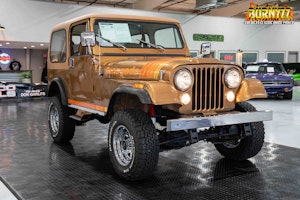
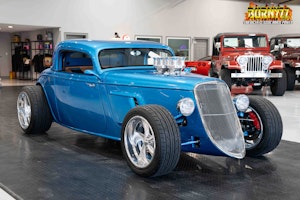























Several of us warned but that is now in the past. You admit making a mistake and that is enough punishment.
The fact is for towing and for high miles and doing cost effective repairs it is tough to replace a Chevy or GMC truck. Tons of parts at reasonable prices. they have simple engines with cheap parts. and if you want used parts it is all out there.
Imports and these new Turbo engines are costly and are not cheap or easy to repair. Even Fords with the new engines and aluminum bodies are not cost effective unless you can find an older one.
This applies to Tahoe’s and Suburbans as being cost effective.
The Honda would never have done the heavy lifting and if the BMW had high miles it would be expensive every repair.
Aw C’mon, man – this vehicle has been providing you with a lot of content for the column, you can’t be THAT mad at it. And really, some of the stuff that’s getting to you is what you – truthfully – admit that you failed to notice before buying it. Can’t really blame that on the rig! But I said this in the first column’s comments, and seriously, I still maintain that you got a good deal and that you will – in shining Hack Mechanic fashion – continue to sort through the issues and fix them in one way or t’other, Rob. You are an inspiration to a whole lot of us who follow similar paths! 👍
Could not agree more with Dub6 here, Saturday morning reading the Trials & Tribulations of Mr Siegel’s challenges brings me motivation and energy to my pending projects. As in some slam dunks compared to his adventures. I have experienced much of same over years of crazy ( albeit fun ) projects, I’m just forturnate enough not to also have time to photo and chronicle all. Thank you again Rob for making me feel so much better about my progress. Never Stop Drivng, Stay cool.
Rob, as hyperv6 said, we warned you but that is in the past. But we might ask, why do you not believe anything we say? we are here to help, really…. Ok now dump this poor decision and maybe direct your attention to a Southern Tahoe 2008-2012 but not the Yukon because we hate the funky headlights on that generation. 🙂🙂
Go southern and you will never (want to) go back to rust-belt undercarriage. Even if it cost $1500 to ship a $4000 tow-capable rig from the south would still put you way ahead of what you are fighting. Plus you could write about the “purchase from across multiple states” and how you went about it.
I once bought a 97 Subaru Legacy wagon super cheap because it had a soggy interior. I was tearing the car apart for parts anyways. All of the water in the interior was from a loose fitting on a drain hose in the roof for the sun roof –so I would have been mentioning that if you hadn’t already got there.
I’m in the process of getting rid of a daily that is too high needs for what it is. If they take too much money or time for the value they give it can be better to move on…
Yes red clay is Gods rust proofing.
and boy is it a bear to remove!
Agreed. A friend’s dad buys all of his cars southern and brings them back to Canada, then basically drowns them in undercoating.
I bought my ’86 s class from him. It’s originally from Alabama and with 314k miles on the clock, it has one rust bubble on each front fender. That’s it.
This also means his undercoating regimen works cause the car has been up north for around 20 years, and in my care for the last 2 and a half.
Now it lives the sheltered garage life and rarely sees rain, let alone snow.
I’ve said it before and I’ll say it again, if you buy a “perfect” vehicle that suits your needs and needs no interesting/challenging fixes, the HACK MECHANIC column is gonna get pretty darned boring: “Woke up this morning and the rig started right up – no issues to report. See next week’s column for a thrilling report on how well the wiper/washer works – if it rains, that is…”
I bought a 2008 armada, had the same problem!
We just replaced the transmission shaft, front shock, clear out the sunroof because it was leaking, now we’re going to replace the catalytic converter because it’s throw one of the sensors off. Bought our $5k! At 175,000.
I bought a 2008 armada, had the same problem!
We just replaced the transmission shaft, front shock, clear out the sunroof because it was leaking, now we’re going to replace the catalytic converter because it’s throw one of the sensors off. Bought our $5k! At 175,000. Over all I love the armada.
Well don’t go buy a 22-23 Tundra. They are losing engines and dealers are not taking them in trade as they don’t want them. The engine cost to replace is crazy. I know someone that went though it and unloaded the truck before they got a bad rep.
I think there is a recall on this now.
Rust Never Sleeps…
It never even cat-naps!
The message is clear: buy the best example available of what you want, and avoid salt-belt vehicles like the Plague. Unless of course, you can earn money writing about the Hell they put you through. Another message is that many luxuries – the factory-installed roof leak, suspension failure points, electronics of many types, and anything with a computer or “black box” – have a life expectancy that is financially ruinous and very frustrating when time is up.
Stick with old school American rides. And buy from a reputable mechanic and get it certified with a good warranty! Time is too expensive to waste!
If you ever get that hinge pin out, write about it. I have the same problem on my ’61 Econoline. The Dorman tool didn’t work for me either.
Rob…If you borrow an induction heater I’ll bet you could twist that now cut in half hinge pin loose and out without damaging nearby paint…
Good idea
There are lots of reasons I like your articles, Rob. But even if the writing wasn’t great, the vehicle’s quirks not interesting, I would still read because I love the visual reminders of how spoiled I am in the relatively rust-free PNW. Not trying to gloat, just making me appreciate what I have, and how much more difficult my repairs could be instead. Thank you!